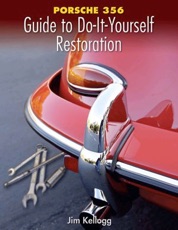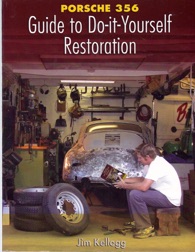Porsche 356 Guide to Do It Yourself Restoration


AUTHOR KELLOGG
ENGLISH
ISBN 10l NO ISBN 10
ISBN 13 9780929758268
ONE IN STOCK @ BLOCKS BOOKS
MY REVIEWS IN THE 356 REGISTRY:
Jim Kellogg’s Porsche 356 Guide to Do It Yourself Restoration, ed 2 appeared at the East Coast Holiday. Almost 50% larger, at 146 from 103 pages – and that’s not including the padding of serial numbers from 356 Porsche a Restorer’s Guide to Authenticity, rev iii – Jim has extensively added and expanded rather than rewrite his book. My Porsche skill sets are swap meet, drive and dine, writing checks and bolting things together. I do not do artisan stuff. I was confounded, but comfortably, in Jim’s first edition welding chapter – by his somewhat sketchy welding instructions. Now Jim explains and goes to some lengths to describe his different welding techniques depending on the situation. This is absolutely what a do it yourself welder, but one not specifically familiar with 356s needs; but I was still confounded but not had lost my comfort level as I tried to understand. More useful to most of us are specific sections, especially including replacing rubber trim and repairing a sunroof – thing we might accomplish without restoring the whole car. Jim is clear about specific tools and materials required for each job.
The paper and photo reproduction are generally adequate but not outstanding. Both Duane’s & Jim’s books date prior to the current age of glossy pages and color photos and are worse for it.
While I complained previously about the lack of change in the cover of Duane’s new book, and the cover to Porsche 356 Guide to Do It Yourself Restoration, ed 2 is different and attractive, I miss the homunculus of the first edition. During my review of Porsche 356 Guide to Do It Yourself Restoration, ed 1 I had written that most, not all, of the problems arising between an owner and the restorer are not do to the restorer being a crook but to the owner just not understanding what is needed. I do need to confess that at least in my case this was not true; but still thing anyone contemplating a restoration must read this book first. The price is unchanged at $29.95.

ENGLISH
AUTHOR KELLOGG
ISBN 10 0929758234
ISBN 13 9780929758237
OUT OF PRINT -- CURRENTLY UNAVAILABLE @ BLOCKS BOOKS
FROM MY REVIEWS IN THE 356 REGISTRY:
Porsche 356 Guide to Do It Yourself Restoration, by Jim Kellogg, is yet another book which should be on any 356 enthusiast’s shelf. Whether you buy a 356 needing work or just drive until it does, sooner of later you will either need to deliver yourself up to the tender mercies of a body, or even more expensive, a restoration shop or contemplate doing the work yourself. While extremely competent restoration experts have commented, there are gems in Jim’s book useful even at their level; I feel that the main usefulness of this book for the vast majority of us is to help the Porsche owner understand what a restoration entails – of course this is written by one whose main 356 skills extend to swap meet, drive and dine, and writing checks. Jim’s book is nicely broken down into sections, so the more enterprising among you can try a repair without obligating yourself for the full Monte. Small – the book is selling well so perhaps soon Jim will start writing the expanded second edition – but reasonably priced at $24.95.
Over the last few years, a substantial body of literature has appeared, covering everything from originality (Porsche 356 – A Restorer’s Guide to Originality) to engine rebuilding (the currently out of print ABCs & 912s Of Porsche Engines and Secrets of the Inner Circle) to performance modifications (Porsche 356 Performance Guide) to even the purchase and philosophy of owning a 356 (Buying, Driving & Enjoying the Porsche 356). Prominent by its absence has been a book on the actual mechanics of restoration. Now, however, Jim Kellogg, bringing years of practical experience, has written Porsche 356 Guide to do it Yourself Restoration. Recognizing that the dozen or so shops capable of a full concours restoration would not actually need a book, Jim is aiming his book at those wishing to restore it themselves.
Guide to do it Yourself Restoration is divided into logical sections, starting with Preliminary Steps – wherein one of the major befits of the book may be quickly realized. You need not be doing a restoration to take advantage of Jim’s instructions; right at the start you are told how to remove gasoline from the various 356s. Just about every 356, at some time in its life, needs to have its gas tank drained. Also useful are the listings, with photographs, of the chassis serial number locations.
Following in logical progression (including tools needed) are chapters on Disassembly (including instructions on removing door panels – yet more useful information, even if you are not restoring your 356), Paint and Rust Removal – including how to properly secure your 356 to a trailer (again useful information in and of itself), Metal Work (here things get a little doggy – this may not be where one really wants a beginner’s primmer on welding, but it may help in a general way with understanding, Paint Preparation (I am not clear as to why testing and installing the fuel tank should be in this section), and Reassembly (tips on carpet installation and masking doors to prevent paint chips are obvious once read). But we are now only on page 73. I wanted more hints, suggestions and stories, and found myself wishing that this book had been several hundred pages longer. There are also appendices with useful information on Finding a 356, Determining the Value of a Project 356 (e.g., if the restored value is $20,000 and you are doing disassembly and reassembly, the seller needs to give you the car for free, plus an additional $1800 if you are going to break-even), Sunroof installation, Nose Replacement, Brakes, Selecting a Painter, and Swap Meet (I should have been guest editor; my two Porsche strengths are swap meet and drive and dine). Final appendices include color charts and Chassis Number list – extremely useful, but the information has not been upgraded from that in Authenticity, revision iii.
For those who are actually doing a major restoration, hints abound. After cutting the floors out, but before fitting new ones – paint the tunnel. Jim presents an alternate method of replacing longitudinals and he recommends flanging door skin bottoms rather than butt-welding.
On first blush, Guide to do it Yourself Restoration might seem to be of limited appeal – there are remarkably few of us who are actually going to attempt a do it ourselves. But Guide to do it Yourself Restoration is not useful just for restoration. It is written modularly and consists of mini-projects. For those of us about to undertake a restoration, it provides an invaluable guide to evaluation and understanding. While there are clearly dishonest shops, far and away the most common cause of dissatisfaction between owner and shop is a failure to communicate. With Guide to do it Yourself Restoration, you should be able to communicate knowledgeably with your restoration artist. I am reviewing from a Xerox pre-production copy, so cannot evaluate the quality of the photographs, but they do seem to be carefully composed and show what Jim is trying to demonstrate.
As with the best of the “how to do it” books, the thought (accurate or otherwise) keeps crossing my mind: “I could do this.” At $24.95 this book should be on every 356 owner’s self. But I want an expanded second edition – so don’t hesitate to let Jim know what you want added.


